Cultural immersion wedding styles in India are becoming the trend of choice for couples who want their big day to be more than just an event—to take everyone on an experience that is a journey into their heritage.
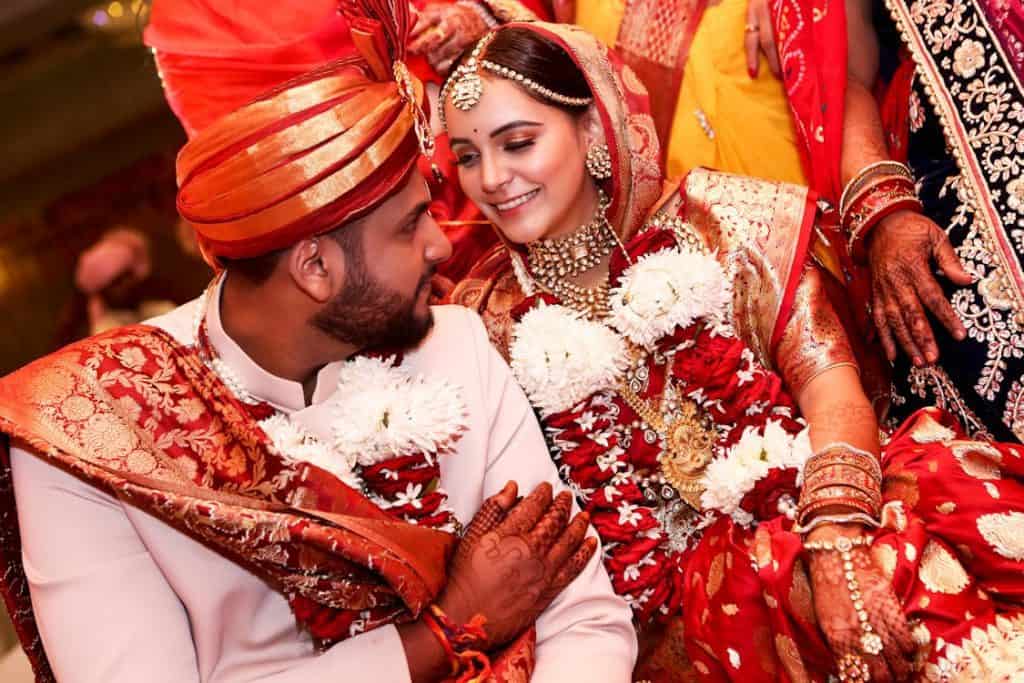
Culturally immersive weddings in India go beyond vows and decorations, turning every moment into a vibrant celebration of traditions that have shaped their identities. Whether it’s a majestic Rajasthani fort or the serene backwaters of Kerala, the venue itself is chosen to reflect the couple’s roots, setting the stage for a cultural spectacle that speaks volumes.
As the air fills with the rhythmic beats of folk music—from the spirited energy of Bhangra drums to the soulful tunes of Manganiyar singers—it creates a festive atmosphere that draws everyone into the celebration. Guests indulge in regional delicacies like Dal Baati Churma or a traditional South Indian Sadhya, served on banana leaves, each bite a taste of the authentic flavours of the land.
Traditional dances like Ghoomar and Kathakali grace the event with their elegance, turning the wedding into the ultimate cultural immersion showcase. From the bride’s intricate Kanjeevaram saree to the groom’s regal sherwani, every detail is thoughtfully curated to honour their legacy. These weddings aren’t just about two people—they’re about blending traditions with elegance, making cultural immersion the ultimate wedding trend for those who seek to celebrate love with meaning and grace.
Locations: Where Tradition Meets Splendour
When it comes to cultural immersion weddings, choosing the right location is everything. It’s not just about picking a pretty spot—it’s about finding a place that breathes life into the traditions, customs, and stories that make your wedding uniquely yours. Imagine tying the knot in the grandeur of Udaipur’s City Palace or Jaipur’s Rambagh Palace.
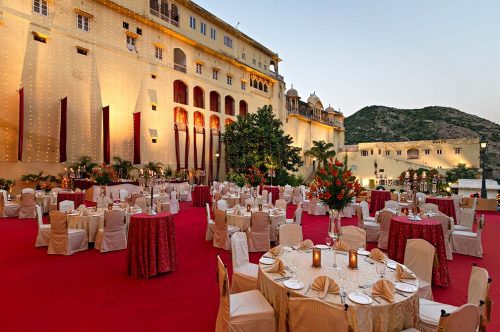
These Rajasthani palaces speak of centuries of royal heritage, with their intricate carvings, towering domes, and courtyards that once hosted kings and queens. You walk through these halls, and it’s like stepping back in time, where every stone has a story, and every corner whispers of a bygone era.
If you’re drawn to the tranquil vibes of Kerala, the backwaters of Alleppey and Kumarakom offer a completely different kind of magic where you can immerse yourself in vibrant greenery, tranquil waters reflecting the sky, and houseboats gracefully drifting in the distance. This setting becomes the perfect stage for a traditional Malayali wedding, where earthy décor made from coconut leaves and jasmine flowers adds a touch of authenticity and grace.
For couples looking to blend their love story with the spirit of ancient India, Tamil Nadu’s Mahabalipuram is a stunning choice. Its seaside charm combined with ancient temple ruins gives your wedding a historical twist. Couples exchange vows as the waves gently crash in the background, under the timeless gaze of ancient stone-carved deities that have witnessed centuries of devotion. It’s like intertwining your own love story with the rich tapestry of history.
But let’s not stop there! If you’re enchanted by the mystique of the Himalayas, how about a wedding in Himachal Pradesh’s Palampur or Manali? These hill stations offer the perfect blend of mountain beauty and rich culture. Palampur’s tea gardens and pine forests provide a dreamy backdrop, while traditional Himachali rituals add a touch of mountain magic to your big day. It’s perfect for those couples who want a mix of serenity, spirituality, and spectacular views.
For a touch of spiritual ambience, Varanasi, the city of temples on the banks of the Ganges, offers a deeply sacred setting for a wedding. There’s something profoundly moving about performing wedding rituals under the evening sky, with the holy river as your witness. The chants, the aroma of incense, the diyas floating on the water—it all creates a scene that feels like it’s straight out of a dream.
And if you’re seeking a destination that brings both coastal and cultural vibes, Goa has more to offer than just its beaches. Think traditional Goan temples, Portuguese-style chapels, and old heritage homes that can transform your wedding into a celebration infused with both local Goan traditions and a hint of colonial charm. A wedding here isn’t just about the venue—it’s about the rich culture, the Konkani songs, and the delicious Goan delicacies that make the experience so warm and personal.
So, if you’re dreaming of a regal Rajasthani affair, a serene Malayali celebration, a mystical Himachali union, a sacred ceremony on the ghats of Varanasi, or a coastal Goan fiesta, each of these locations does more than just host your wedding. They turn it into a celebration that’s rooted in tradition, culture, and the timeless beauty of India’s diverse heritage. Every detail, from the venue’s architecture to the local customs and cuisine, comes together to create a wedding that’s not just seen but felt deeply by everyone present.
The Music and Folk Dances: Rhythm of Tradition
In modern Indian weddings, music and dance aren’t just add-ons—they’re the heartbeat of the celebration, setting the mood and making each moment truly unforgettable. Traditional folk dances, in particular, play a vital role in infusing the joyous atmosphere with cultural pride, symbolizing blessings, and bringing people together in celebration.
A Punjabi wedding is never complete without the electrifying beats of Bhangra and Gidda, driven by the rhythm of the Dhol, Chimta, and Tumbi. Bhangra, with its energetic movements, has become synonymous with wedding celebrations, ensuring that the entire gathering is on its feet. During Virat Kohli and Anushka Sharma’s post-wedding celebrations, renowned Punjabi folk singer Gurdas Maan took the stage, amplifying the energy as everyone danced to Bhangra beats. This lively dance not only honoured their Punjabi roots but also added a playful twist with witty Boliyan, characteristic of the vibrant spirit of Punjabi weddings.
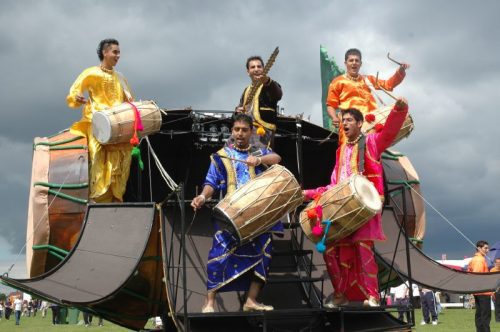
In Rajasthani weddings, the festivities come alive with the enchanting sounds of the Shehnai and Dholak, creating the perfect stage for the iconic Ghoomar dance. This graceful folk dance, performed by women in vibrant lehengas, showcases elegant twirls and movements that symbolize blessings for the newlyweds. When Katrina Kaif and Vicky Kaushal tied the knot, their wedding brought Ghoomar to life, blending Rajasthani elegance with modern-day magic, transforming the event into a mesmerizing spectacle of tradition and beauty.
Moving to Gujarat, Garba and Dandiya Raas are essential parts of wedding celebrations, where guests perform circular movements around a deity or central figure, reflecting the harvest’s bounty and the joy of union. Priyanka Chopra and Nick Jonas, in their lavish multicultural wedding, embraced these traditions by likely incorporating elements of Garba into their pre-wedding festivities, bridging their cultural roots with the festive spirit of Gujarat.
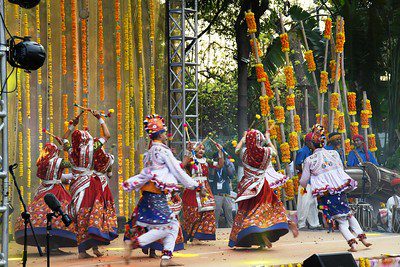
Similarly, Shilpa Shetty and Raj Kundra honoured their Mangalorean and Punjabi heritage by likely incorporating both Garba and Bhangra into their celebrations, demonstrating how Indian weddings seamlessly blend different regional customs. They also included an energetic dance from Kumaon, Uttarakhand, called Chholiya which involves male dancers armed with swords and shields. It is often performed during marriage processions, adding a spirited touch to the festivities.
In Maharashtra, the fast-paced Lavani dance, accompanied by rhythmic beats, often marks joyous occasions. Genelia D’Souza and Riteish Deshmukh, who celebrated their wedding with both Maharashtrian and Christian rituals, included Lavani as part of their Maharashtrian wedding festivities, showcasing the cultural diversity that Indian weddings proudly embrace.
Down in Kerala, the powerful beats of Chenda Melam signal something sacred and grand. The traditional drums echo through the air, creating a spiritual atmosphere, while Kudamattam, a rhythmic dance involving changing colorful parasols, adds a touch of elegance. This blessed Asin Thottumkal’s wedding with Kerala’s vibrant cultural energy, turning the event into a sacred yet celebratory experience. Similarly, Mouni Roy and Suraj Nambiar’s wedding incorporated elements from various cultures, including Bengali and Kerala traditions.
In Bengali weddings, the soulful melodies of Baul music, played on the Ektara and Dotara, fill the air, carrying songs of love and divine connection. At Rani Mukerji’s ceremony, these melodies brought a sense of peace and spirituality, grounding the celebrations in the deep-rooted cultural traditions of Bengal.
These weddings highlight the rich tapestry of Indian culture and also showcase how traditional folk dances and music can elevate the celebratory atmosphere during such significant life events. From the energetic beats of Bhangra to the graceful twirls of Ghoomar, these traditional dances breathe life into each celebration.
Traditional Cuisine: A Culinary Journey Through Cultures
Food is the soul of the celebration, where each dish is a nod to the couple’s roots.
In Bengali weddings, the menu is a sweet lover’s paradise, showcasing delights like Mishti Doi, Rasgulla, Shorshe Ilish, and Kosha Mangsho. The mix of mustard-spiced and sugary treats perfectly sums up Bengal’s love for bold flavours. At celebrity weddings like that of Shahid Kapoor and Mira Rajput, the fusion of tradition and creativity stood out with a spread that included inventive sushi chaat served on props resembling stacks of books, highlighting how modern twists can elevate the dining experience.
In Eastern India, wedding feasts reflect the region’s deep culinary heritage. Dishes like Macher Jhol, a light fish curry made with seasonal vegetables, and Chingri Malai Curry, prawns cooked in coconut milk, bring out the region’s love for fresh, local ingredients. These traditional dishes, along with the iconic Shorshe Ilish, a Hilsa fish delicacy cooked in mustard sauce, form the backbone of Bengali wedding menus.
Weddings like that of Anant Ambani and Radhika Merchant showcased how culinary artistry can take centre stage. Their event featured over 2,500 vegetarian dishes, including creations by world-renowned chefs like Virgilio Martínez, known for his innovative Peruvian dishes. The menu spanned global cuisines, with standout items such as Tender Coconut Carpaccio and Glazed King Oyster Mushroom Xacuti. The dessert spread was no less impressive, featuring visually stunning edible masterpieces like caviar atop tiramisu, blending the lines between food and art.
In Rajasthani weddings, it’s all about the rich flavours of Dal Baati Churma, Gatte ki Sabzi, and the fiery Laal Maas. Served with a touch of royalty on elegant silverware, these dishes give the guests a taste of Rajasthan’s legendary culinary heritage. When Priyanka Chopra and Nick Jonas celebrated their wedding at Jodhpur’s Umaid Bhawan Palace, they treated their guests to this grand Rajasthani spread, blending luxury with tradition in every bite.
Down south, it’s a feast for the senses with the classic Sadhya served on banana leaves. This South Indian spread features dishes like Avial, Erissery, Payasam, and Thoran, all packed with the vibrant flavours of coconut. The banana leaf setup not only keeps it authentic but also adds an earthy vibe to the whole experience. Similarly, when Deepika Padukone and Ranveer Singh tied the knot in Lake Como, they honoured their roots with a mix of Konkani-Mangalorean and Sindhi-Punjabi cuisines. Their wedding feast included traditional delicacies like Dal Pakwan, Sev Barfi, and Puliogare, all served on banana leaves, blending the essence of both cultures.
Weddings in India elevate traditional cuisine to extraordinary levels, turning the entire dining experience into a feast for both the palate and the eyes.
Attire: Draping Tradition in Elegance
When we talk about cultural weddings, the attire transcends fashion—it’s a living expression of heritage, regional craftsmanship, and timeless elegance. Each ensemble reflects a tapestry woven with the couple’s cultural roots, turning their special day into a beautiful narrative of tradition and love.
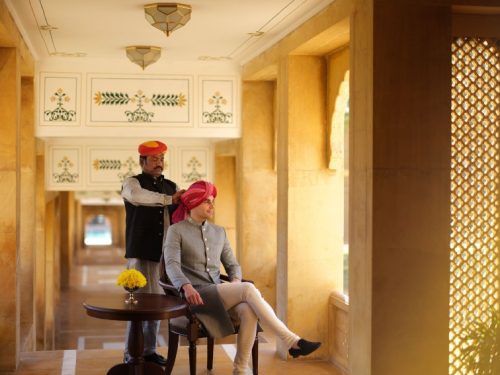
Take Rajasthan, for example, where brides often dazzle in Lehengas adorned with Bandhani or Leheriya patterns—vibrant designs bursting with colour and history. Paired with exquisite Kundan and Polki jewellery, these ensembles radiate royal grandeur. Designers like Sabyasachi Mukherjee and Manish Malhotra craft these stunning pieces, which can range from INR 5 lakhs to over INR 50 lakhs, using intricate embroidery and luxurious fabrics that echo the legacy of Rajasthan’s royal heritage. Grooms elevate their look with a finely tailored Sherwani, often detailed with embroidery and topped off with a Safa (turban) adorned with jewels or a sarpech (turban ornament).
Sidharth Malhotra and Kiara Advani took the traditional Rajasthani look to new heights at their wedding at the regal Suryagarh Palace in Jaisalmer. Kiara’s blush pink Manish Malhotra lehenga, worth around INR 25 lakhs, was a vision of elegance with its intricate embroidery, perfectly paired with Polki jewellery made from uncut diamonds. Sidharth complemented her look in a regal gold-toned Sherwani by the same designer, bringing in all the elegance of traditional Rajasthani motifs to match the palace’s opulent vibe.
In Kerala, brides keep it elegant and understated with the classic Kasavu saree—a white saree with gold borders that symbolizes purity. Paired with traditional gold temple jewellery, this look stays true to Kerala’s rich cultural roots. Grooms typically don a Mundu and Veshti, reflecting the region’s minimalist yet dignified style, where tradition takes centre stage over extravagance.
Tamil Nadu weddings shine with the luxurious Kanjeevaram sarees, celebrated for their intricate gold zari work and vivid colours. These sarees, ranging from INR 1 lakh to INR 15 lakhs, are as much a work of art as they are a bridal outfit. Celebrity brides like Nayanthara have embraced this look, stunning in a rich red saree by Jade by Monica and Karishma, priced at around INR 25 lakhs. Her groom, Vignesh Shivan, chose a traditional silk dhoti ensemble, bringing the elegance of Tamil culture to the forefront
Rituals: Time-Honoured Traditions
Rituals are the heartbeat of cultural weddings, infusing the celebration with layers of meaning that blend tradition with modern elegance. These time-honoured practices reflect stories in motion, turning each ceremony into a living tapestry of culture and history.
Take a Bengali wedding, for example, where the Saat Paak ritual is a show-stopper. The bride is lifted onto a wooden stool called a Piri, her eyes coyly covered with beetle leaves, as she circles the groom seven times. It’s more than a dance—it’s a symbolic act that ties their fates together, a beautiful moment of shared destiny. The ritual peaks when the groom applies Sindoor (vermilion) to the bride’s forehead, marking her as a married woman in the most iconic Bengali way, a tradition steeped in cultural pride.
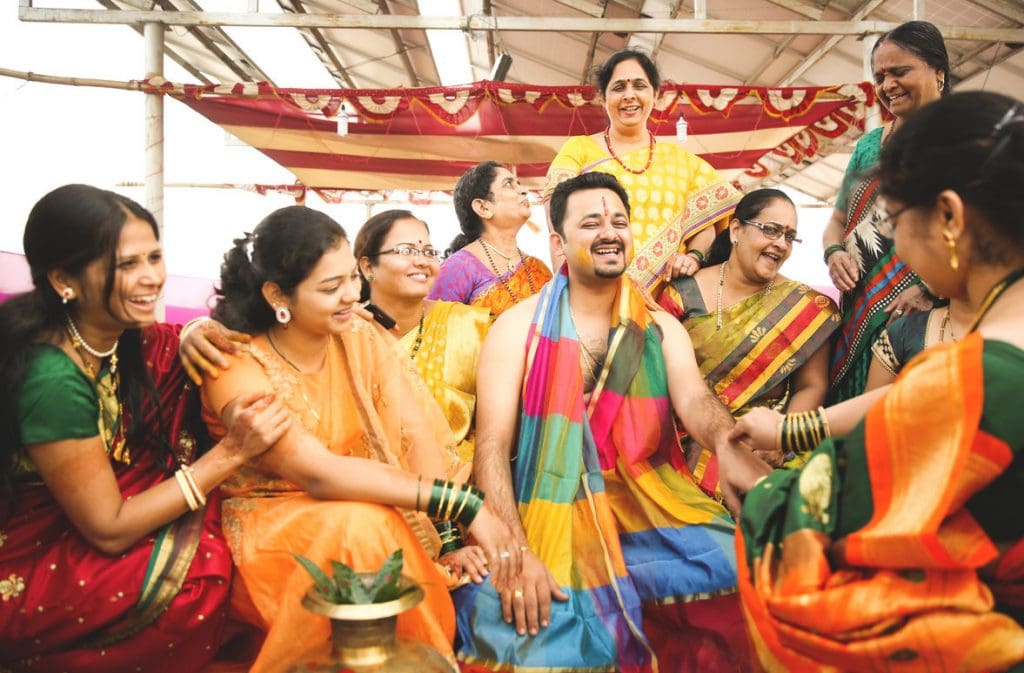
Head down south, and a South Indian wedding takes the symbolism up a notch with the Kanyadaan and Mangalsutra ceremonies. Picture the bride’s father placing her hand into the groom’s, signifying a bond of trust and passing of responsibility. Then comes the moment when the groom ties the Mangalsutra—a sacred thread with black beads—around the bride’s neck. This isn’t just jewellery; it’s a promise, a bond of love and protection that’s sealed in front of the sacred fire, binding their souls together in a ritual that speaks volumes without a single word.
When Deepika Padukone and Ranveer Singh tied the knot at the picturesque Villa del Balbianello in Lake Como, Italy, they brought these traditions to the global stage. Even in this fairytale setting, they stayed true to their roots, incorporating the Phoolon Ki Chaadar (floral canopy) under which Deepika was gracefully escorted to the mandap, symbolizing a protective blessing from her loved ones.
Their ceremony also featured the sacred Saptapadi, where they took seven steps around the holy fire, each step representing a vow to stand by each other through every phase of life. This stunning blend of ancient rituals with modern-day elegance turned their wedding into a perfect fusion of cultural heritage and contemporary romance.
These rituals are powerful moments that connect the couple to their roots while making their big day uniquely meaningful.
Celebrating Love: A Fusion of Tradition and Modernity
Cultural immersion weddings are a tribute to the heritage that shapes our identities. These weddings beautifully blend tradition, local flavours, and the couple’s unique touch, creating a ceremony that’s as much about honouring roots as it is about celebrating the future. It’s about the merging of families, cultures, and worlds in the most authentic and meaningful way.
These celebrations are like a living canvas that paints the past, present, and future in vibrant hues. From grand venues steeped in history to folk dances, soulful local music, and attire rich in cultural significance, every element tells a story that goes beyond the ordinary. Cultural immersion weddings are experiences that bring traditions to life, fill hearts with joy, and mark the beginning of a shared journey with layers of meaning.
For couples across the globe, choosing a culturally immersive wedding is a powerful way to honour their roots and infuse their love story with the richness of their heritage.
Read more: Latest



